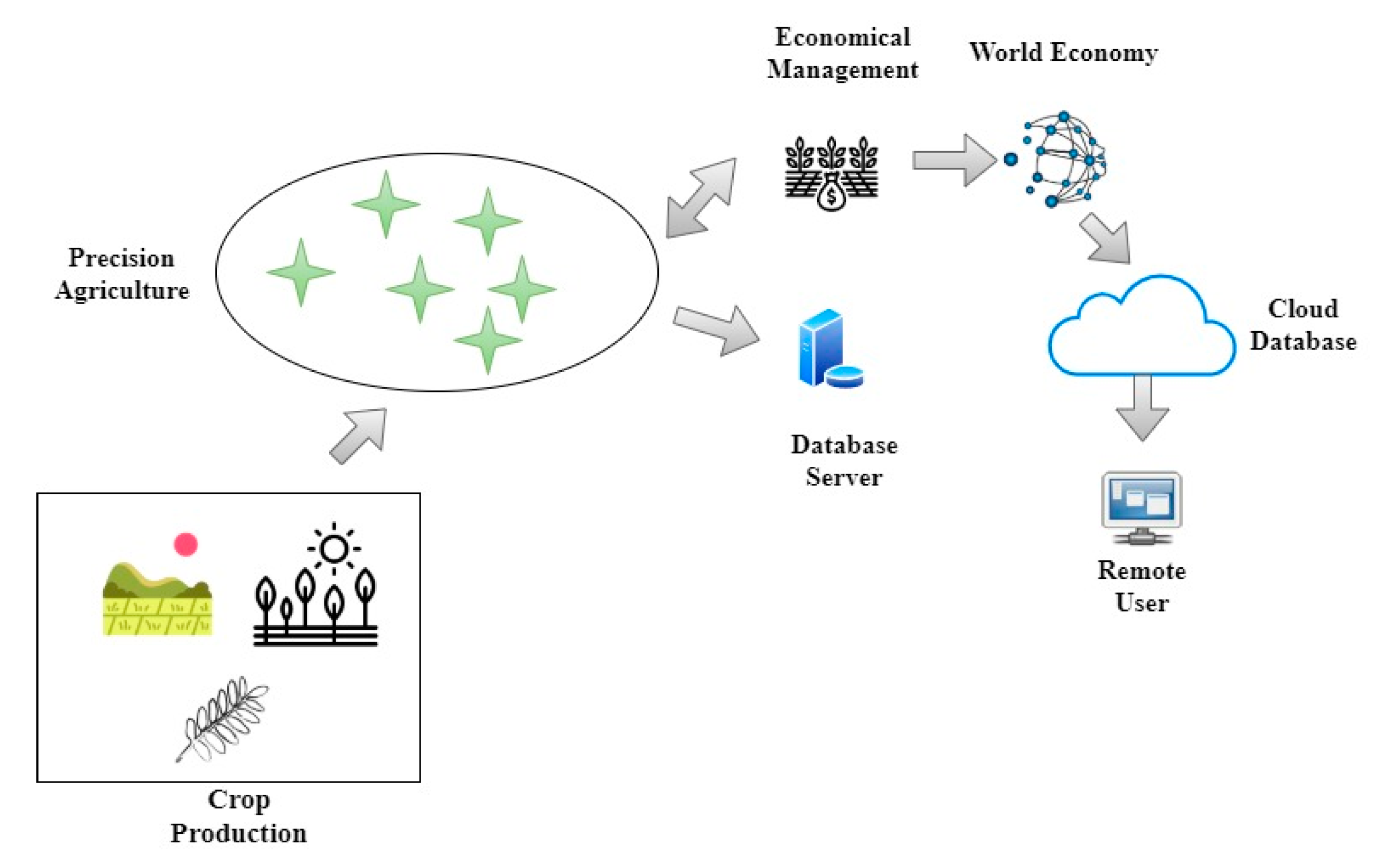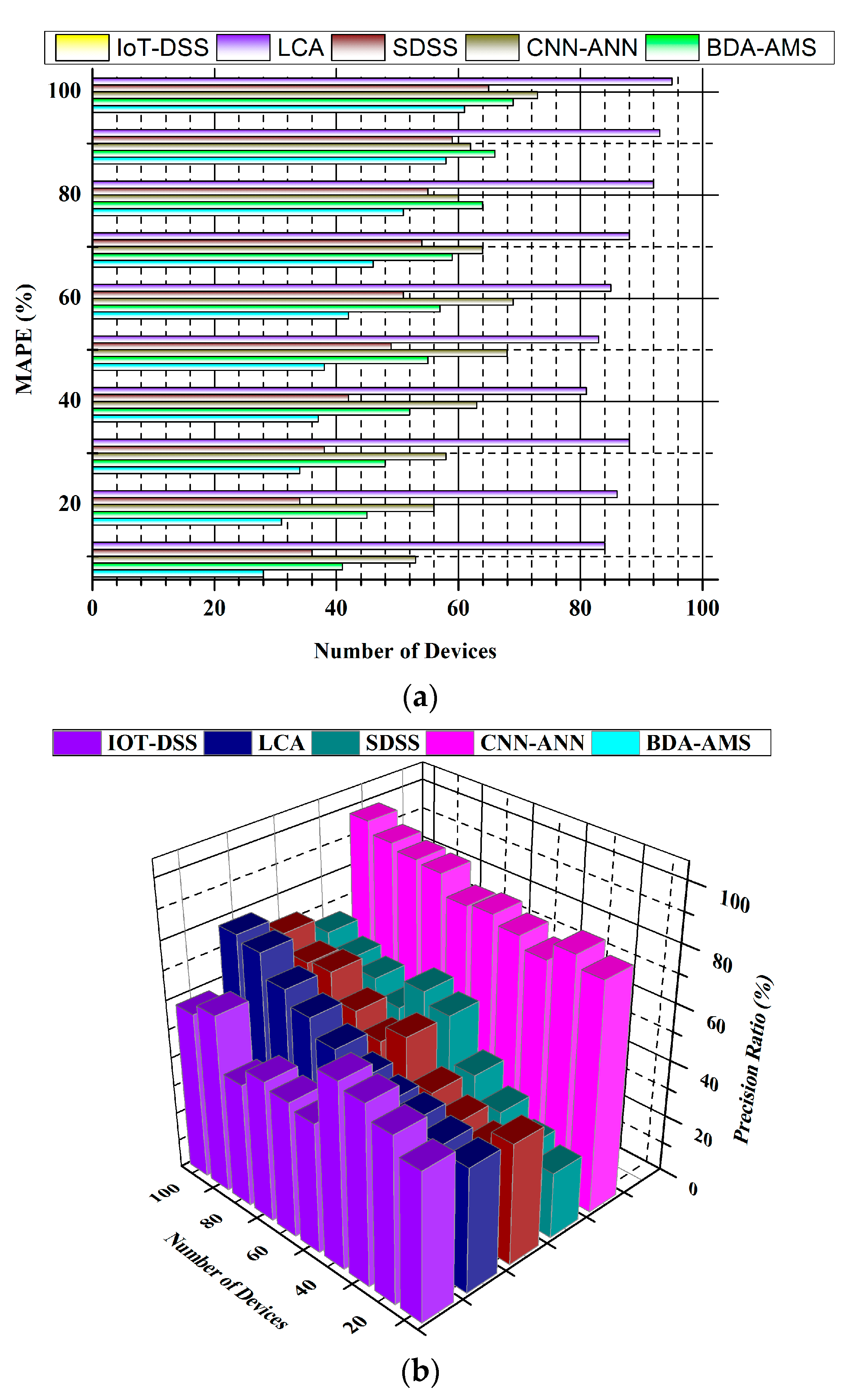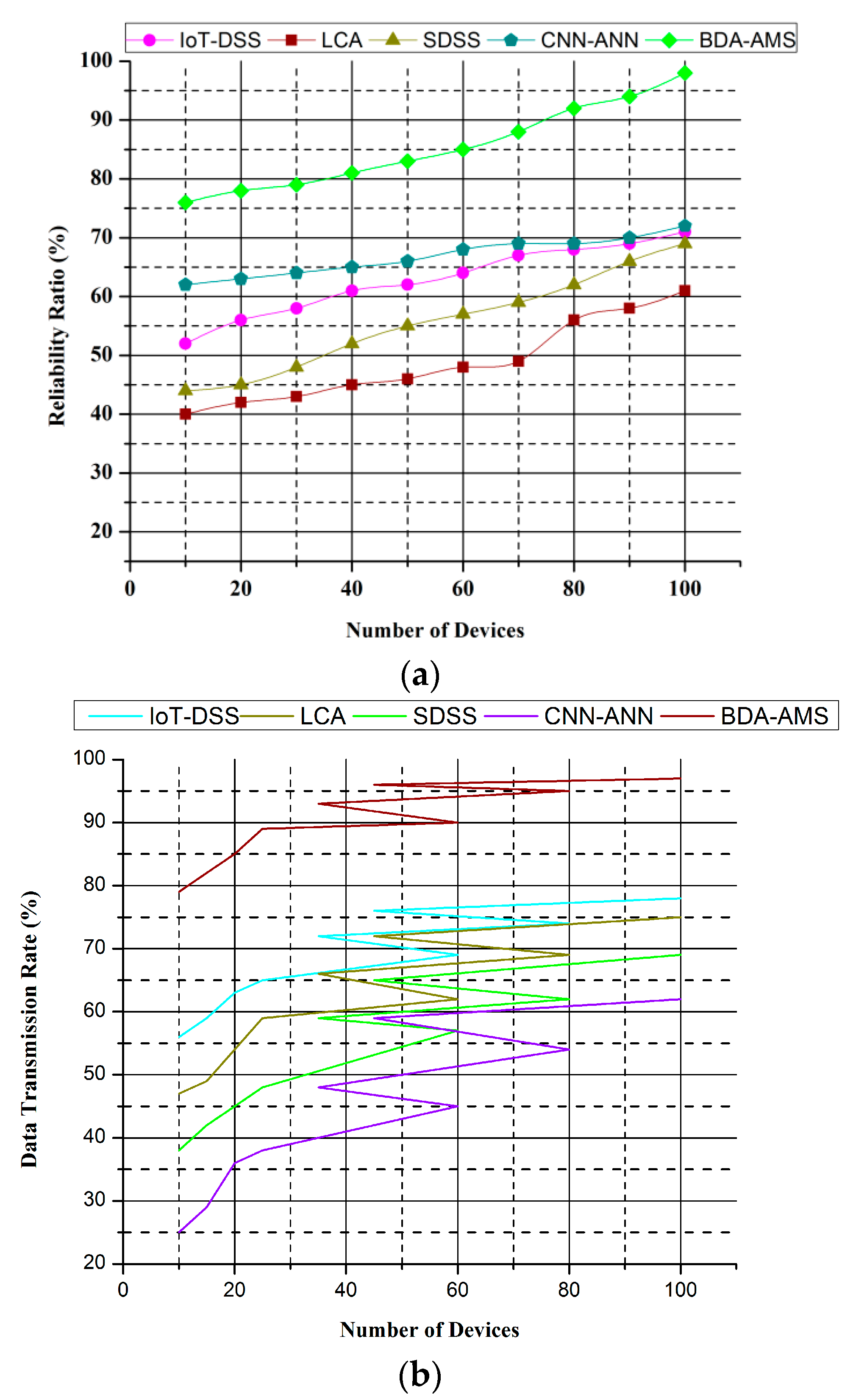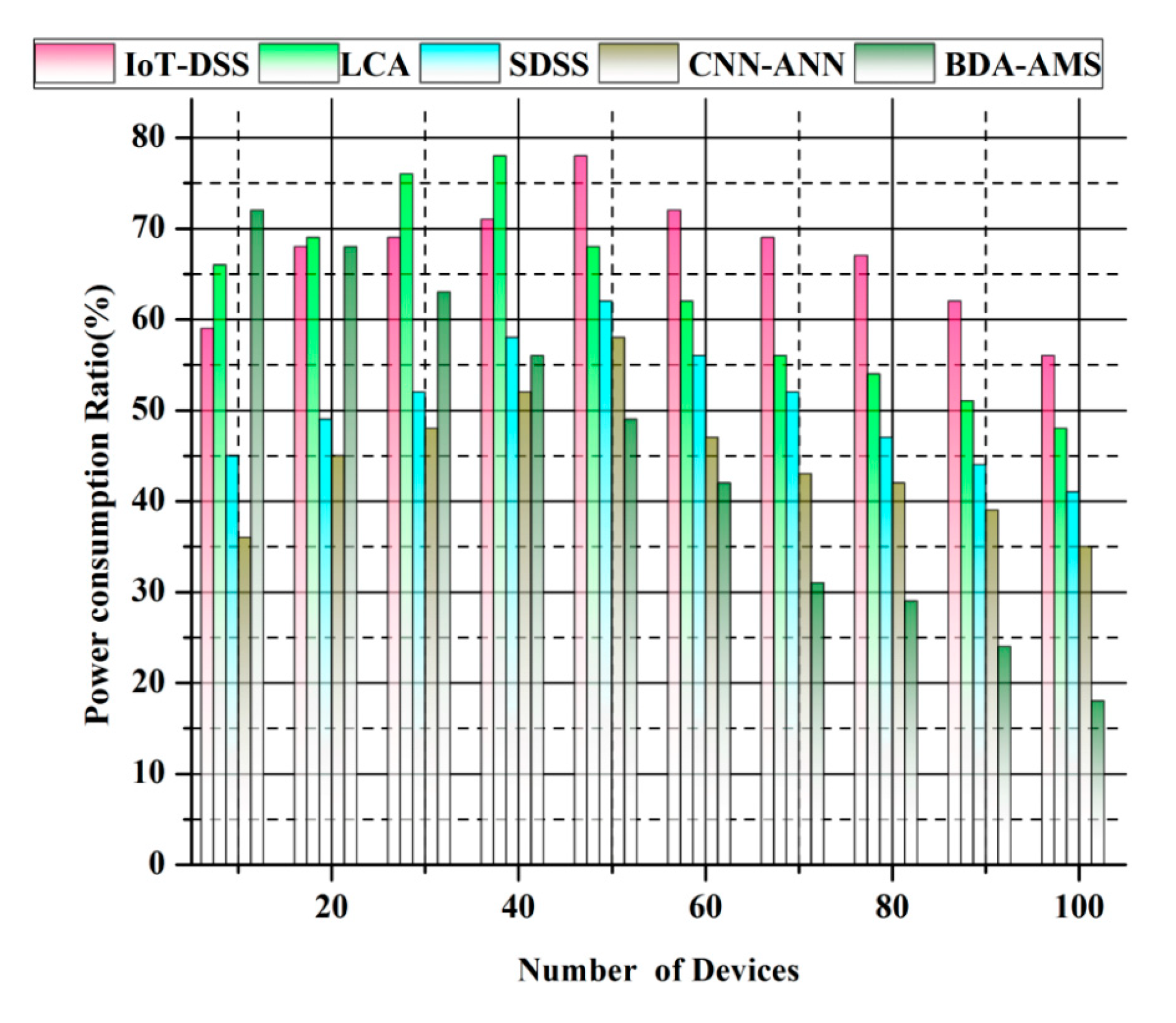Development Trends in Precision Agriculture and Its Management in China Based on Data Visualization
Abstract
:1. Introduction
1.1. Background and Origin of the Research
1.2. Literature Works
2. Big Data Analytics-Initiated Agriculture Monitoring System (BDA-AMS)
2.1. Reasons for System Design
2.2. BDA-AMS’ Basic Framework and Main Principles
2.3. Operation of System
3. Results and Discussion
3.1. Precision Ratio (%) and Mean Absolute Percentage Ratio (%)
3.2. Data Transmission Rate (%) and Reliability Ratio (%)
3.3. Accuracy Ratio (%)
3.4. Performance Ratio (%)
3.5. Power Consumption Ratio (%)
3.6. Weather Forecasting Ratio (%)
3.7. Production Density (%)
4. Conclusions and Future Work
Author Contributions
Funding
Data Availability Statement
Conflicts of Interest
References
- Mekonnen, Y.; Namuduri, S.; Burton, L.; Sarwat, A.; Bhansali, S. Machine learning techniques in wireless sensor network-based precision agriculture. J. Electrochem. Soc. 2019, 167, 037522. [Google Scholar] [CrossRef]
- Sankar, S.; Srinivasan, P.; Luhach, A.K.; Somula, R.; Chilamkurti, N. Energy-aware grid-based data aggregation scheme in routing Protocol for agricultural internet of things. Sustain. Comput. Inform. Syst. 2020, 28, 100422. [Google Scholar] [CrossRef]
- Nie, X.; Fan, T.; Wang, B.; Li, Z.; Shankar, A.; Manickam, A. Big data analytics and IoT in operation safety management in underwater management. Comput. Commun. 2020, 154, 188–196. [Google Scholar] [CrossRef]
- Tantalaki, N.; Souravlas, S.; Roumeliotis, M. Data-driven decision making in precision agriculture: The rise of big data in agricultural systems. J. Agric. Food Inf. 2019, 20, 344–380. [Google Scholar] [CrossRef]
- Varatharajan, R.; Manogaran, G.; Priyan, M.K. A big data classification approach using LDA with an enhanced SVM method for ECG signals in cloud computing. Multimed. Tools Appl. 2018, 77, 10195–10215. [Google Scholar] [CrossRef]
- Elhoseny, M.; Abdelaziz, A.; Salama, A.S.; Riad, A.M.; Muhammad, K.; Sangaiah, A.K. A hybrid model of the internet of things and cloud computing manages big data in health services applications. Future Gener. Comput. Syst. 2018, 86, 1383–1394. [Google Scholar] [CrossRef]
- Manogaran, G.; Vijayakumar, V.; Varatharajan, R.; Kumar, P.M.; Sundarasekar, R.; Hsu, C.H. Machine learning-based big data processing framework for cancer diagnosis using a hidden Markov model and GM clustering. Wirel. Pers. Commun. 2018, 102, 2099–2116. [Google Scholar] [CrossRef]
- Reddy Maddikunta, P.K.; Hakak, S.; Alazab, M.; Bhattacharya, S.; Reddy Gadekallu, T.; Zada Khan, W.; Pham, Q.V. Uncrewed Aerial Vehicles in Smart Agriculture: Applications, Requirements, and Challenges. IEEE Sens. J. 2021, 21, 17608–17619. [Google Scholar] [CrossRef]
- Perakis, K.; Lampathaki, F.; Nikas, K.; Georgiou, Y.; Marko, O.; Maselyne, J. CYBELE–Fostering precision agriculture livestock farming through secure access to large-scale HPC-enabled virtual industrial experimentation environments fostering scalable big data analytics. Comput. Netw. 2020, 168, 107035. [Google Scholar] [CrossRef]
- Manogaran, G.; Hsu, C.H.; Rawal, B.S.; Muthu, B.A.; Mavromoustakis, C.X.; Mastorakis, G. ISOF: Information Scheduling and Optimization Framework for Improving the Performance of Agriculture Systems Aided by Industry 4.0. IEEE Internet Things J. 2020, 8, 3120–3129. [Google Scholar] [CrossRef]
- Anbarasan, M.; Muthu, B.; Sivaparthipan, C.B.; Sundarasekar, R.; Kadry, S.; Krishnamoorthy, S.; Dasel, A.A. Detection of flood disaster system based on IoT, big data, and convolutional deep neural network. Comput. Commun. 2020, 150, 150–157. [Google Scholar] [CrossRef]
- Chen, J.; Ramanathan, L.; Alazab, M. Holistic, big data integrated artificial intelligent modeling to improve privacy and security in smart cities’ data management. Microprocess. Microsyst. 2021, 81, 103722. [Google Scholar] [CrossRef]
- Peters, E.; Kliestik, T.; Musa, H.; Durana, P. Product decision-making information systems, real-time big data analytics, and deep learning-enabled smart process planning in sustainable industry 4.0. J. Self-Gov. Manag. Econ. 2020, 8, 16–22. [Google Scholar]
- Kuch, D.; Kearnes, M.; Gulson, K. The promise of precision: Datafication in medicine, agriculture, and education. Policy Stud. 2020, 41, 527–546. [Google Scholar] [CrossRef]
- Alazab, M.; Hong, S.H.; Ng, J. Louder bark with no bite: Privacy protection through the regulation of mandatory data breach notification in Australia. Future Gener. Comput. Syst. 2021, 116, 22–29. [Google Scholar] [CrossRef]
- Kumar, N. Call for Special Issue Papers: Internet of Things Data Visualization for Business Intelligence: Deadline for Manuscript Submission: September 12, 2020. Big Data 2020, 8, 249–250. [Google Scholar] [CrossRef]
- Jindal, A.; Kumar, N.; Singh, M. A unified framework for big data acquisition, storage, and analytics for demand response management in smart cities. Future Gener. Comput. Syst. 2020, 108, 921–934. [Google Scholar] [CrossRef]
- Garg, S.; Singh, A.; Kaur, K.; Aujla, G.S.; Batra, S.; Kumar, N.; Obaidat, M.S. Edge computing-based security framework for big data analytics in VANETs. IEEE Netw. 2019, 33, 72–81. [Google Scholar] [CrossRef]
- Niu, H.; Hollenbeck, D.; Zhao, T.; Wang, D.; Chen, Y. Evapotranspiration Estimation with Small UAVs in Precision Agriculture. Sensors 2020, 20, 6427. [Google Scholar] [CrossRef]
- Guillén, M.A.; Llanes, A.; Imbernón, B.; Martínez-España, R.; Bueno-Crespo, A.; Cano, J.C.; Cecilia, J.M. Performance evaluation of edge-computing platforms for the prediction of low temperatures in agriculture using deep learning. J. Supercomput. 2021, 77, 818–840. [Google Scholar] [CrossRef]
- Balfe, É.L.; Jorge, L.A.D.C.; Sanches, I.D.A.; Luchiari Júnior, A.; da Costa, C.C.; Victoria, D.D.C.; Ramirez, A.R. Precision and Digital Agriculture: Adoption of Technologies and Perception of Brazilian Farmers. Agriculture 2020, 10, 653. [Google Scholar] [CrossRef]
- Afzaal, H.; Farooque, A.A.; Abbas, F.; Acharya, B.; Esau, T. Computation of evapotranspiration with artificial intelligence for precision water resource management. Appl. Sci. 2020, 10, 1621. [Google Scholar] [CrossRef] [Green Version]
- Popescu, D.; Stoican, F.; Stamatescu, G.; Ichim, L.; Dragana, C. Advanced UAV–WSN system for intelligent monitoring in precision agriculture. Sensors 2020, 20, 817. [Google Scholar] [CrossRef] [Green Version]
- Escamilla-Garcia, A.; Soto-Zarazúa, G.M.; Toledano-Ayala, M.; Rivas-Araiza, E.; Gastélum-Barrios, A. Applications of Artificial Neural Networks in Greenhouse Technology and Overview for Smart Agriculture Development. Appl. Sci. 2020, 10, 3835. [Google Scholar] [CrossRef]
- Ma, L.; Long, H.; Zhang, Y.; Tu, S.; Ge, D.; Tu, X. Agricultural labor changes and agricultural economic development in China and their implications for rural vitalization. J. Geogr. Sci. 2019, 29, 163–179. [Google Scholar] [CrossRef] [Green Version]
- Liang, L.; Wang, Y.; Ridoutt, B.G.; Lal, R.; Wang, D.; Wu, W.; Zhao, G. Agricultural subsidies assessment of cropping system from environmental and economic perspectives in North China based on LCA. Ecol. Indic. 2019, 96, 351–360. [Google Scholar] [CrossRef]
- Li, W.; Clark, B.; Taylor, J.A.; Kendall, H.; Jones, G.; Li, Z.; Frewer, L.J. A hybrid modeling approach to understanding adoption of precision agriculture technologies in Chinese cropping systems. Comput. Electron. Agric. 2020, 172, 105305. [Google Scholar] [CrossRef]
- Sieverding, H.; Kebreab, E.; Johnson, J.M.; Xu, H.; Wang, M.; Grosso, S.J.D.; Stone, J.J. A life cycle analysis (LCA) primer for the agricultural community. Agron. J. 2020, 112, 3788–3807. [Google Scholar] [CrossRef]
- Mohapatra, A.G.; Lenka, S.K.; Keswani, B. Neural network and fuzzy logic-based smart DSS model for irrigation notification and control in precision agriculture. Proc. Natl. Acad. Sci. India Sect. A Phys. Sci. 2019, 89, 67–76. [Google Scholar] [CrossRef]
- Pham, T.N.; Van Tran, L.; Dao, S.V.T. Early Disease Classification of Mango Leaves Using Feed-Forward Neural Network and Hybrid Metaheuristic Feature Selection. IEEE Access 2020, 8, 189960–189973. [Google Scholar] [CrossRef]
- Bhat, S.A.; Huang, N.F. Big Data and AI Revolution in Precision Agriculture: Survey and Challenges. IEEE Access 2021, 9, 110209–110222. [Google Scholar] [CrossRef]













| Symbol | Description |
|---|---|
| G | Measured resistance |
| σ | Molar conductivity |
| FB | Temperature traction |
| O | Molar |
| N | Cell-constant |
| Uj | Value of the ion charge |
| eq | Translation factor of temperature |
| q | Temperature |
| a0a1 | Regression coefficients |
| Y | Number-dependent variable |
| Number of Devices | Weather Forecasting Ratio (%) | ||||
|---|---|---|---|---|---|
| IoT-DSS | LCA | SDSS | CNN-ANN | BDA-AMS | |
| 10 | 21.836 | 15.937 | 17.852 | 19.231 | 84.622 |
| 20 | 20.401 | 16.765 | 17.727 | 19.342 | 85.711 |
| 30 | 19.094 | 14.657 | 17.494 | 19.659 | 86.315 |
| 40 | 18.024 | 14.922 | 17.571 | 23.987 | 87.318 |
| 50 | 18.882 | 16.342 | 17.790 | 23.567 | 88.724 |
| 60 | 17.852 | 12.212 | 18.234 | 23.459 | 90.648 |
| 70 | 17.727 | 14.254 | 18.345 | 25.671 | 91.727 |
| 80 | 15.974 | 13.084 | 18.675 | 30.222 | 92.922 |
| 90 | 15.571 | 16.145 | 18.879 | 33.567 | 93.321 |
| 100 | 15.128 | 14.124 | 19.111 | 34.987 | 94.864 |
| Number of Devices | Production Density (%) | ||||
|---|---|---|---|---|---|
| IoT-DSS | LCA | SDSS | CNN-ANN | BDA-AMS | |
| 10 | 31.836 | 65.937 | 77.852 | 84.231 | 91.622 |
| 20 | 30.401 | 66.765 | 77.727 | 84.342 | 92.711 |
| 30 | 39.094 | 64.657 | 77.494 | 85.659 | 92.315 |
| 40 | 38.024 | 64.922 | 78.571 | 86.987 | 93.318 |
| 50 | 38.882 | 66.342 | 78.790 | 86.567 | 94.724 |
| 60 | 47.852 | 72.212 | 79.234 | 87.459 | 94.648 |
| 70 | 47.727 | 74.254 | 80.345 | 88.671 | 95.727 |
| 80 | 45.974 | 63.084 | 81.675 | 89.222 | 96.922 |
| 90 | 55.571 | 66.145 | 82.879 | 90.567 | 97.321 |
| 100 | 55.128 | 64.124 | 83.111 | 90.987 | 98.864 |
Publisher’s Note: MDPI stays neutral with regard to jurisdictional claims in published maps and institutional affiliations. |
© 2022 by the authors. Licensee MDPI, Basel, Switzerland. This article is an open access article distributed under the terms and conditions of the Creative Commons Attribution (CC BY) license (https://creativecommons.org/licenses/by/4.0/).
Share and Cite
Song, C.; Ma, W.; Li, J.; Qi, B.; Liu, B. Development Trends in Precision Agriculture and Its Management in China Based on Data Visualization. Agronomy 2022, 12, 2905. https://doi.org/10.3390/agronomy12112905
Song C, Ma W, Li J, Qi B, Liu B. Development Trends in Precision Agriculture and Its Management in China Based on Data Visualization. Agronomy. 2022; 12(11):2905. https://doi.org/10.3390/agronomy12112905
Chicago/Turabian StyleSong, Chuanhong, Wenbo Ma, Junjie Li, Baoshan Qi, and Bangfan Liu. 2022. "Development Trends in Precision Agriculture and Its Management in China Based on Data Visualization" Agronomy 12, no. 11: 2905. https://doi.org/10.3390/agronomy12112905
APA StyleSong, C., Ma, W., Li, J., Qi, B., & Liu, B. (2022). Development Trends in Precision Agriculture and Its Management in China Based on Data Visualization. Agronomy, 12(11), 2905. https://doi.org/10.3390/agronomy12112905







